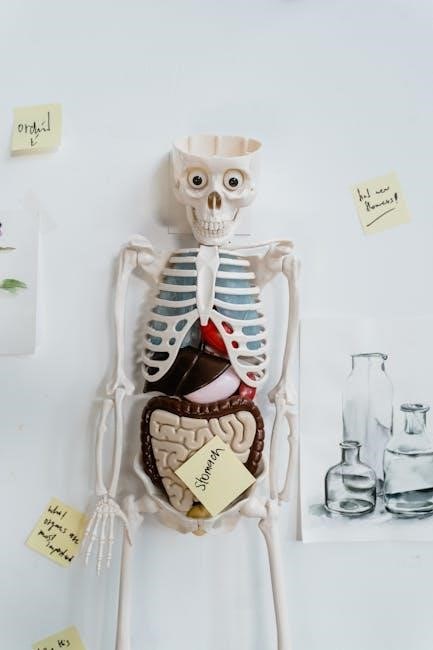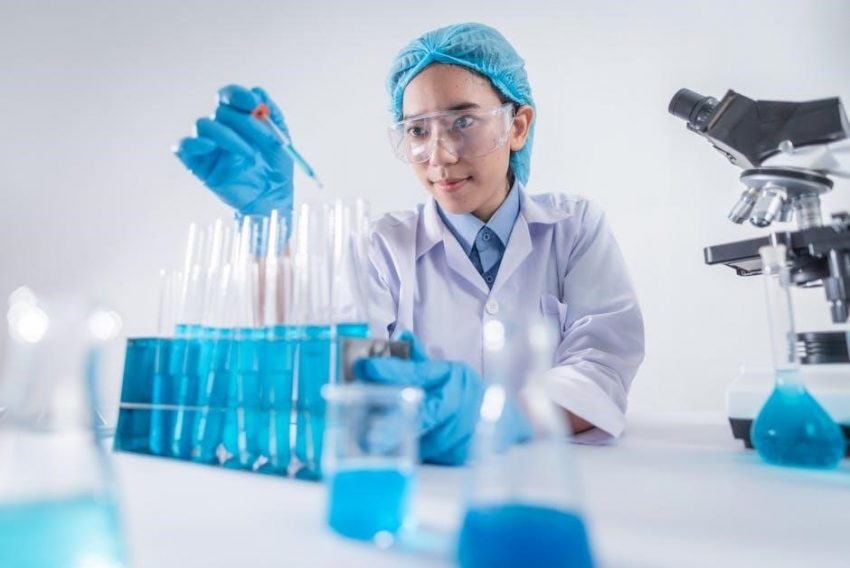Biology is the study of life and living organisms, exploring their structure, function, growth, origin, evolution, and distribution. It is essential for understanding life’s fundamental processes and addresses topics like cells, genetics, and ecosystems, providing insights into everyday life. Study guides and practice questions are invaluable tools for mastering key concepts and acing exams.
1.1 Key Concepts and Definitions
Biology is the scientific study of life and living organisms. Key concepts include cells as the basic units of life, DNA as the genetic material, and evolution as the driving force of diversity. Essential terms like photosynthesis, respiration, and ecosystems are fundamental. Understanding these concepts and definitions is crucial for mastering biology and excelling in exams. Use study guides and flashcards for effective preparation.
1.2 Importance of Biology in Everyday Life
Biology impacts medicine, agriculture, and conservation. It helps develop vaccines, improve crop yields, and understand ecological balance. Biological knowledge informs public health policies and environmental decisions. Studying biology fosters critical thinking and problem-solving skills, benefiting careers in science, healthcare, and beyond. Everyday applications highlight its significance in advancing human welfare and sustainability.

Cells and Cellular Structure
Cells are the basic structural and functional units of life. They consist of a cell membrane, cytoplasm, and organelles like mitochondria and ribosomes. Cells vary in shape, size, and function, playing a critical role in sustaining life and enabling biological processes.
2.1 Cell Membranes and Transport
Cell membranes are semi-permeable barriers regulating the movement of substances in and out of cells. Passive transport includes diffusion, osmosis, and facilitated diffusion, while active transport requires energy to move molecules against concentration gradients. These processes are vital for maintaining cellular homeostasis, enabling nutrient uptake, and waste removal, ensuring proper cell function and survival.
2.2 Organelles and Their Functions
Organelles are specialized structures within cells, each performing unique roles. The nucleus houses DNA, controlling cell activities. Mitochondria generate energy through ATP production. Ribosomes synthesize proteins, essential for growth and repair. The endoplasmic reticulum processes proteins and lipids, while the Golgi apparatus modifies and transports them. Lysosomes contain digestive enzymes, breaking down cellular waste. These organelles work together to maintain cellular function and overall organism health.
Genetics and Heredity
Genetics and heredity involve the study of how traits are inherited through DNA and genes, shaping life’s diversity and guiding evolution over generations.
3;1 DNA Structure and Replication
DNA’s double helix structure, composed of nucleotides, is crucial for genetic information storage. Replication involves unwinding by helicase, with DNA polymerase synthesizing new strands. This semi-conservative process ensures genetic continuity. Understanding replication mechanisms and repair is vital for genetics. Study tips: Use diagrams to visualize processes and practice questions on replication errors and repair mechanisms for exam success.
3.2 Mendelian Inheritance and Punnett Squares
Mendelian inheritance explains how traits are passed through generations, following laws of segregation and independent assortment. Punnett squares predict genotype and phenotype probabilities, aiding in understanding dominant and recessive traits. Practice questions often involve calculating ratios and interpreting genetic outcomes. Use flashcards to memorize key terms and concepts for a solid grasp of hereditary principles.
3.3 Modern Genetic Techniques
Modern genetic techniques like CRISPR-Cas9 enable precise gene editing, while DNA sequencing identifies genetic codes. PCR amplifies DNA for analysis, and gene cloning produces identical genes. These tools revolutionize medicine, agriculture, and biotechnology. Practice questions cover applications and ethical considerations, helping students grasp their transformative impact on research and practical uses. Use flashcards to master these advanced methods.
Energy and Metabolism
Energy and metabolism are central to life, involving the conversion of energy through processes like photosynthesis and respiration. ATP is a key energy carrier, while enzymes catalyze reactions. Understanding these processes is crucial for grasping how organisms function and interact with their environment. Study guides often emphasize metabolic pathways and energy transfer mechanisms for exam success.
4.1 Photosynthesis and Respiration
Photosynthesis and respiration are vital processes for energy conversion in living organisms. Photosynthesis involves converting sunlight, water, and CO2 into glucose and oxygen, while respiration breaks down glucose to produce ATP, releasing CO2 and water. These processes are interrelated and essential for sustaining life and ecosystems. Understanding their mechanisms and importance is crucial for biology exams, as highlighted in many study guides.
4.2 ATP and Energy Transfer
ATP (Adenosine Triphosphate) is the primary energy currency of cells, transferring energy from metabolic processes to cellular activities. It captures energy from photosynthesis and respiration, storing it in phosphate bonds. Hydrolysis of ATP releases energy, powering functions like muscle contraction, transport of molecules, and biosynthesis. Understanding ATP’s role is crucial for grasping energy flow and cellular metabolism, as emphasized in many biology study guides.

Ecology and Environment
Ecology explores the interactions between organisms and their environment, studying ecosystems, biomes, and energy flow. It addresses conservation biology and the impact of human activities on biodiversity.
5.1 Ecosystems and Biomes
An ecosystem is a community of living organisms interacting with their non-living environment, governed by energy flow and nutrient cycles. Biomes are large, stable ecosystems like forests or deserts, shaped by climate. Understanding these systems is crucial for conservation biology and managing human impacts on biodiversity and natural resources.
5.2 Food Chains and Energy Flow
Food chains depict the flow of energy from producers (plants) to consumers (animals) through feeding relationships. Energy transfers are inefficient, with only 10% passing to the next trophic level. This pyramid structure explains why biomass decreases at higher levels. Understanding energy flow is key to analyzing ecosystem balance and the impact of human activities on biomes and biodiversity.
5.3 Conservation Biology
Conservation biology focuses on preserving biodiversity and addressing threats to ecosystems. Key strategies include habitat restoration, species reintroduction, and combating invasive species. Climate change, pollution, and overexploitation are major challenges. Genetic diversity is crucial for species resilience. Conservation efforts rely on ecological research and international cooperation to protect endangered species and maintain ecosystem balance for future generations.
Evolution and Natural Selection
Evolution explains how species change over time through natural selection, genetic drift, and mutation. It drives adaptation to environments, fostering diversity and complexity in life forms, supported by fossil records and comparative anatomy.
6.1 Mechanisms of Evolution
The primary mechanisms driving evolution include natural selection, where favorable traits enhance survival, and genetic drift, which alters gene frequencies randomly. Mutation introduces new traits, while gene flow transfers genetic material between populations; These processes collectively shape biodiversity and adaptation, ensuring species evolve to thrive in changing environments, as highlighted in study guides and practice questions for comprehensive exam preparation.
6.2 Evidence for Evolution
The evidence for evolution is vast and includes fossil records showing transitional forms, comparative anatomy revealing homologous structures, and molecular biology demonstrating genetic similarities. Biogeography explains species distribution patterns, while observed evolutionary changes in natural populations and experiments confirm evolutionary principles. These proofs collectively validate the theory of evolution, aiding in comprehensive exam preparation as outlined in study guides and practice questions.
Human Biology and Physiology
Human biology explores the nervous and immune systems, as well as the digestive and circulatory systems, highlighting their complex processes and essential functions in maintaining overall health and bodily operations.
7.1 Nervous and Immune Systems
The nervous system controls bodily functions through neurons and synaptic transmission, enabling communication and response to stimuli. The immune system defends against pathogens, with key components like white blood cells and antibodies. Understanding their interplay is crucial for grasping human health and disease prevention, making them vital topics in any comprehensive biology study guide.
7.2 Digestive and Circulatory Systems
The digestive system breaks down food into nutrients for absorption and energy. The circulatory system transports oxygen, nutrients, and hormones via blood vessels. Both systems are vital for survival, maintaining homeostasis, and supporting cellular functions. Understanding their roles and interactions is essential for grasping human physiology and preparing for exams with detailed biology study guides.

Practice Questions and Answers
This section provides multiple-choice questions and short answer examples to test your understanding of key biological concepts. Use these resources to review and refine your knowledge for exam success.
8.1 Multiple Choice and Short Answer Examples
This section features multiple-choice questions and short answer prompts covering essential biology topics. Questions focus on key concepts like biomolecules, cellular structure, and genetics. Examples include identifying processes like photosynthesis or explaining DNA replication. These exercises help assess understanding and prepare for exams by reinforcing critical thinking and knowledge application.
8.2 Strategies for Exam Success
Effective exam strategies include active learning, such as creating flashcards and attending study sessions. Practice with past papers to familiarize yourself with formats and timing. Review weak areas and organize study schedules. Stay calm, manage time wisely, and ensure proper rest and nutrition. These techniques enhance confidence and performance, helping you approach the exam prepared and focused.

Key Biological Terminology
Biological terminology forms the foundation of biology, including terms like cell, photosynthesis, DNA, and ecosystem. Understanding these definitions is crucial for grasping concepts and excelling in exams.
9.1 Flashcard-Style Definitions
- Cell: The basic structural and functional unit of living organisms.
- Photosynthesis: The process by which plants convert sunlight into energy.
- DNA: Deoxyribonucleic acid, carrying genetic instructions for life.
- Ecosystem: A community of living organisms interacting with their environment.
- Homeostasis: The ability to maintain a stable internal environment.
- Evolution: The process of species change over generations through natural selection.
9.2 Common Misconceptions
- Misconception: Evolution is random; Reality: It’s driven by natural selection and environmental pressures.
- Misconception: All bacteria are harmful; Reality: Many are beneficial, aiding digestion and immunity.
- Misconception: Genes predetermine everything; Reality: Environment and lifestyle significantly influence traits.
- Misconception: Photosynthesis occurs only in plants; Reality: Some bacteria and algae also photosynthesize.
Final Exam Preparation Tips
Develop a study schedule and stick to it. Use active learning techniques like summarizing notes and teaching others. Regularly review past exams to identify weak areas. Stay organized with a dedicated study space and essential materials. Ensure adequate sleep and nutrition to maintain focus and energy levels. Stay positive and seek help when needed.
10.1 Study Techniques and Time Management
Use active recall and spaced repetition for effective learning. Break study sessions into manageable chunks using the Pomodoro Technique. Prioritize challenging topics and allocate time accordingly. Utilize flashcards for vocabulary and key concepts. Review practice exams to familiarize yourself with question formats. Maintain a consistent study schedule and avoid cramming. Balance study with breaks to ensure long-term retention and mental well-being.
10.2 Reviewing and Practicing Past Papers
Practicing past papers helps identify weak areas and improves time management. Start by solving papers without timing, then gradually simulate exam conditions. Focus on understanding common question formats and recurring topics. Review answer keys to analyze mistakes and refine concepts. Regularly practicing past papers builds confidence and familiarity with the exam structure, ensuring better performance on the final day.

